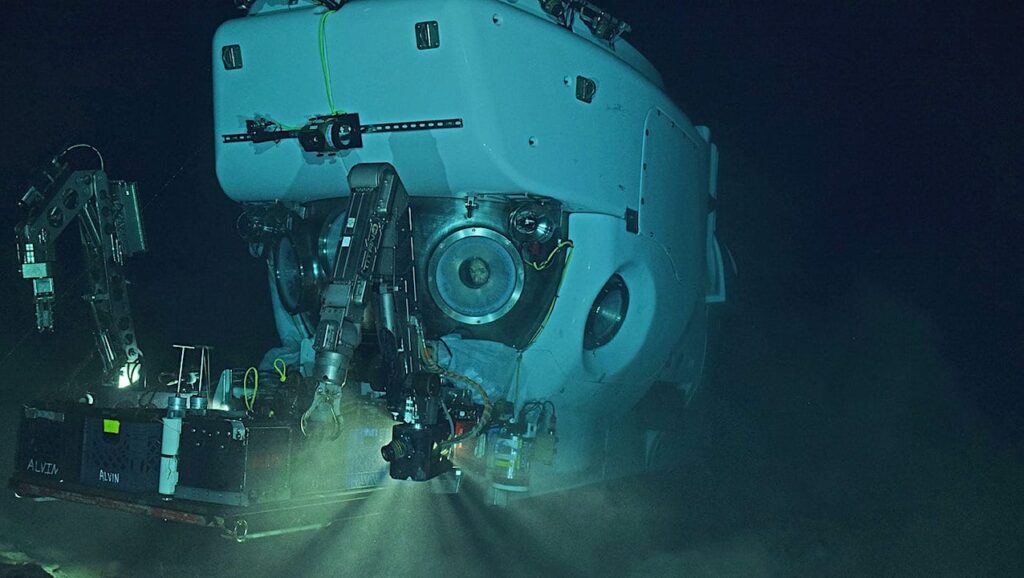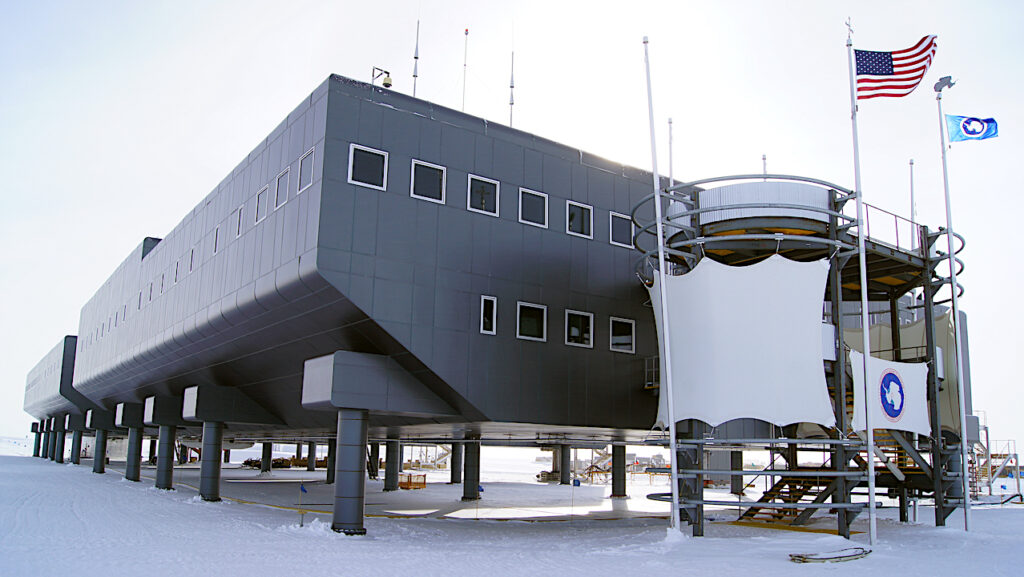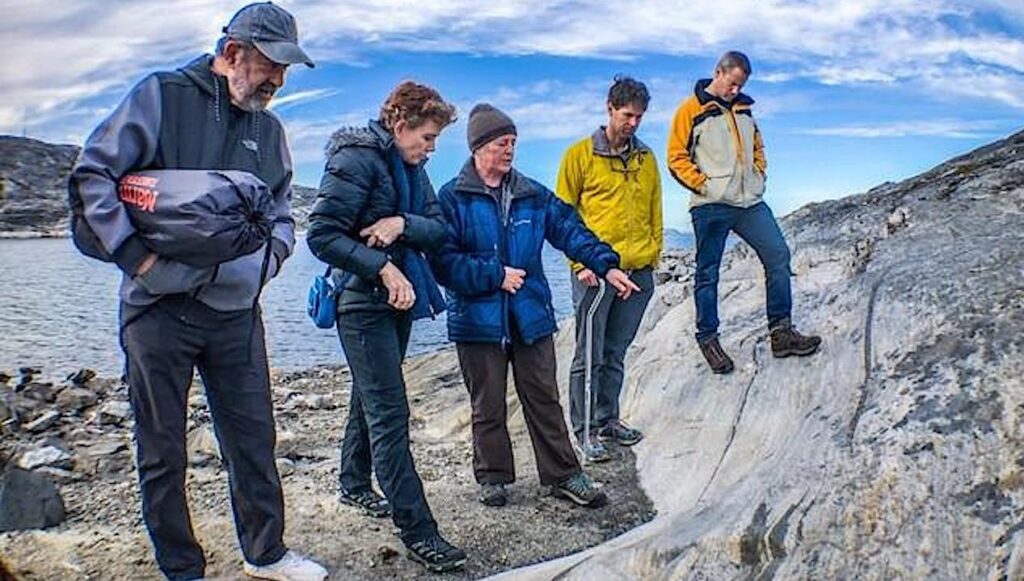Engineering Astrobiology and Exploration
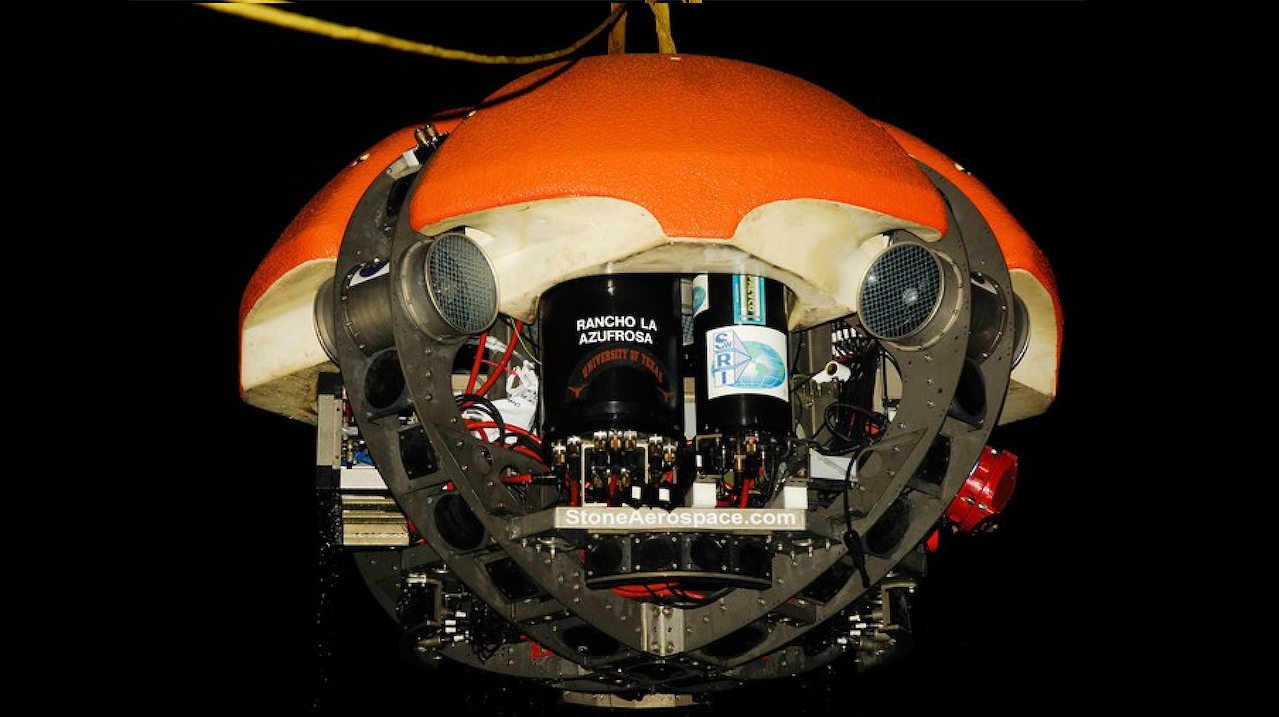
NASA Astrobiology joins in the 2024 Engineers Week (Feb. 18-24) celebration to recognize the contributions of NASA’s engineers, technicians, and technologists to discovery and innovation.
Engineers Week, now known as Eweek, was founded in 1951 by the National Society for Professional Engineers to introduce K-12 students to the many amazing careers available in engineering and technology. This year’s theme is “Welcome to the Future!”, and where better to showcase the future of engineering than at NASA. Astrobiologists rely on engineers to enable new research and discovery, from collecting data in remote locations on Earth to designing and building the sophisticated instruments that fly on NASA missions.
Astrobiologists study the origin and evolution of life on Earth and the potential for life in the Universe. On Earth, they examine the very limits of life in some of the most extreme environments our planet has to offer. In space, astrobiologists use robotic missions to study the habitability of nearby planets and moons, and telescopes to examine Earth-like planets that orbit stars many light-years away.
Engineers work with astrobiologists to solve the challenges we face in mission and instrument design. For instance, how do you build an instrument to collect and study microbes that live hundreds of meters underground? How do you collect measurements in extreme cold, or extreme heat? How do you detect and study light from a star as it passes through the atmosphere of a distant planet, revealing details about its atmosphere? Engineers help astrobiologists overcome these challenges in order to perform their scientific studies.
At NASA, science and engineering are interconnected. Science guides engineering, and engineering enables science.

NASA’s Europa Clipper spacecraft boasts its new 10-foot (3-meter) high-gain antenna, after its Aug. 14, 2023, installation in High Bay 1 of the Spacecraft Assembly Facility at the agency’s Jet Propulsion Laboratory (JPL) in Southern California. IMAGE CREDIT: NASA/JPL-CALTECH.
Thanks to data from spacecraft like Voyager, Galileo, and Juno, we are almost certain that Europa harbors a liquid ocean beneath its icy surface. Astrobiologists have long wondered if this ocean could be habitable, or if life could possibly be swimming in its depths today. The first engineering hurdle in answering this question is getting instruments to the surface of Europa, and then down into the ocean.
Accessing a Subsurface Ocean
The Europa Lander is an example of a concept that engineers have explored to assess the habitability of Europa and search for evidence of life. If there are living cells in Europa’s ocean, biosignatures of that life could find their way up to the surface. A mission like Europa Lander would collect samples from up to 10 centimeters (4 inches) below the surface and analyze them with a miniature laboratory similar to that of the Curiosity rover on Mars.

An artist’s concept of the Europa lander, which is meant to probe the icy moon for signs of life.
IMAGE CREDIT: NASA/JPL-CALTECH.
Some of the challenges that engineers must overcome in designing a mission like the Europa Lander are powering a robot so far away from the Sun and the fact that there would be long blackout periods for communication with the Earth. The lander would also be setting down in unknown territory, with little information available about what the environment of Europa’s surface is actually like up close.
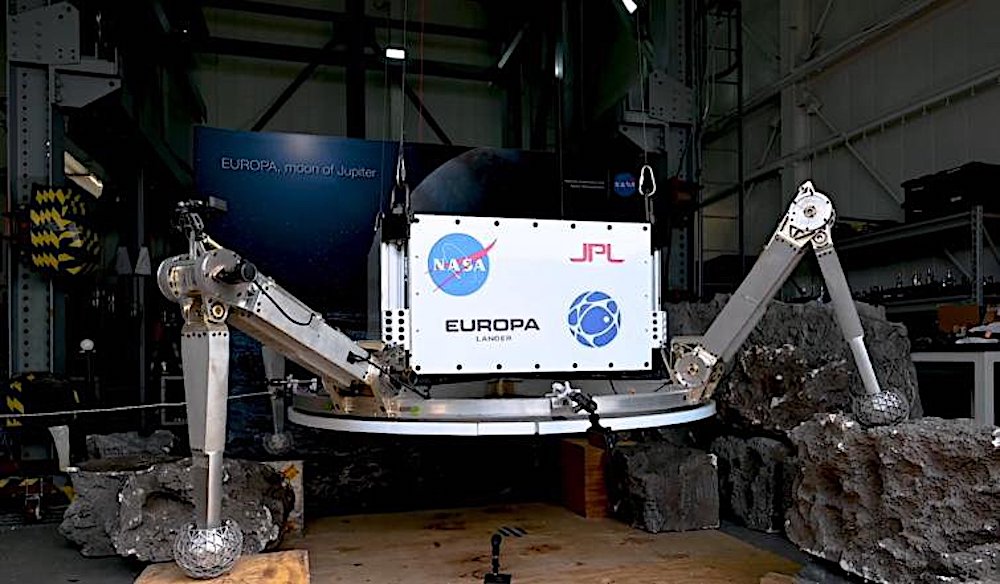
A 2023 test of a landing system for a proposed future mission that would touch down on Jupiter’s icy moon Europa. This system for the proposed Europa Lander is an evolution of hardware used on previous NASA lander missions. IMAGE CREDIT: NASA/JPL-CALTECH.
Once engineers help us reach the surface of Europa, the next step is to look deep below the ice and into the ocean. Melt probes (also known as “cryobots”) are one of the concepts that NASA-supported engineers have looked at to accomplish this task. These probes use a heated tip to move down through the ice.
One example is the Ice Diver, developed at the University of Washington (UW) with support from the National Science Foundation (NSF) and NASA. Ice Diver has passed some preliminary tests here on Earth. With support from NASA’s Scientific Exploration Subsurface Access Mechanism for Europa (SESAME) program, the team tested Ice Diver at the summit of the Greenland Ice Sheet in June 2021. It descended at 10 meters per hour to travel through the ice shelf, reaching a depth of 100 meters below the ice surface and retrieving samples of glacial melt water for microbiological analysis. NASA is currently supporting a new expedition to bring Ice Diver to Alaska through the Planetary Science and Technology from Analog Research (PSTAR) program.

University of Washington engineer Justin Burnett holds the Ice Diver just prior to the beginning of its descent into the ice sheet in Greenland. IMAGE CREDIT: DALE P. WINEBRENNER / UNIVERSITY OF WASHINGTON.
The major challenge for melt probes is the thickness of Europa’s icy shell, which many estimates put at 10 to 15 miles (15 to 25 kilometers). That amount of ice requires a lot of energy to travel through, could contain obstacles that a probe must navigate around, and will make communication with the surface very challenging. In addition, as a probe melts the ice and inches forward, the water behind it will refreeze. These challenges will require autonomous robotic probes capable of real time decision making and communicating with Earth-based science teams.
Exploring in the Dark
Once a mission reaches the ocean of Europa, it then has to navigate. Deep below the ice, on a moon millions of miles away, a robotic explorer won’t be able to rely on instructions or remote guidance from human beings back on Earth. Robotic explorers in Europa’s ocean will have to be autonomous, with software that allows them to assess the environment, collect data, and possibly select, gather, and study samples.

The Deep Phreatic Thermal eXplorer, or DEPTHX. IMAGE CREDIT: JASON TOWNSEND/STONE AEROSPACE.
Engineers supported by NASA have long been working on autonomous robots for space exploration. This includes underwater vehicles like the Deep Phreatic Thermal Explorer (DEPTHX) which was used in 2007 to autonomously explore the Cenote Zacatón in Mexico (the world’s deepest known freshwater hydrothermal spring). The bottom of this deep, dark water is fed by geothermal vents and had never been reached before. DEPTHX was able to make the journey by using a new navigational technology known as 3D real-time SLAM (for “simultaneous localization and mapping”).
The robotic explorer utilized geometrical feature recognition to correct errors in traditional navigation methods. This method could also be used by a robotic explorer to identify and use features for navigation on the underside of the Europan ice cap or on the floor of the Europan ocean, enabling it to search for life over greater distances while safely returning to a point where it could upload its findings to Earth.
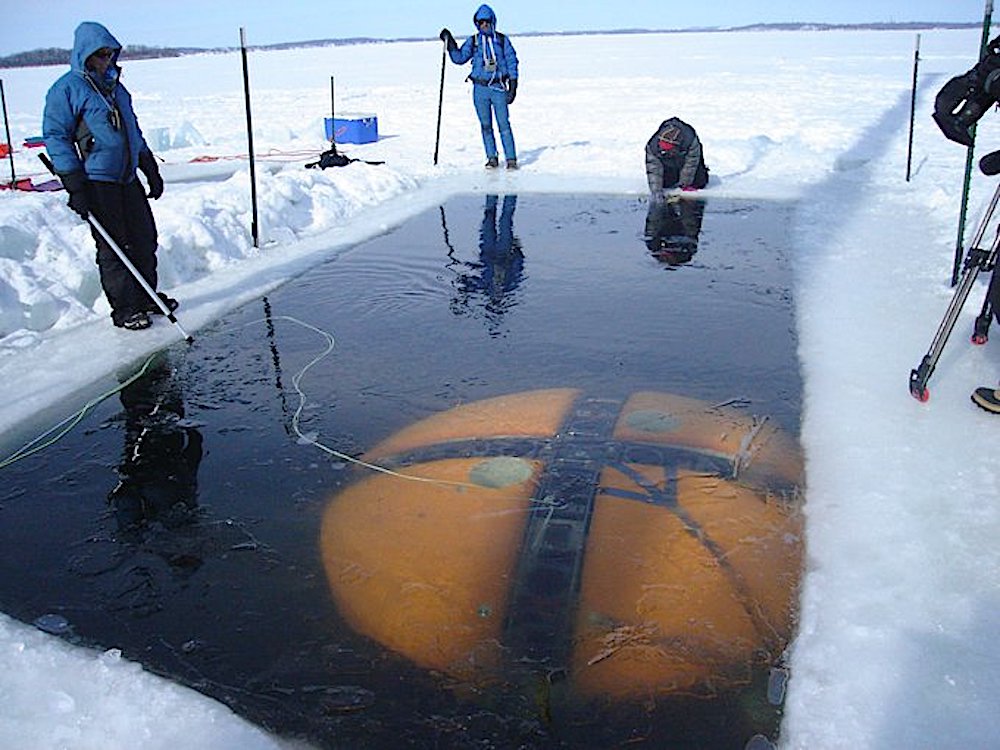
A field test of ENDURANCE (Environmentally Non-Disturbing Under-ice Robotic ANtarctiC Explorer) in Wisconsin. This robot has been used to investigate the waters of Lake Bonney in Antarctica. IMAGE CREDIT: NASA/STONE AEROSPACE.
Later, researchers brought a modified version of that submersible robot, dubbed ENDURANCE (the Environmentally Non-Disturbing Under-ice Robotic ANtarctic Explorer), to Earth’s most southerly continent. In Antarctica, ENDURANCE became the first robot to explore a subglacial lake. It created three-dimensional maps of both geometry and water chemistry beneath the ice shelf. Using this data ENDURANCE discovered a previously unknown hypersaline water source at the bottom of subglacial Lake Bonney. Such capabilities can help autonomous robots navigate towards energy sources that support microbial life.
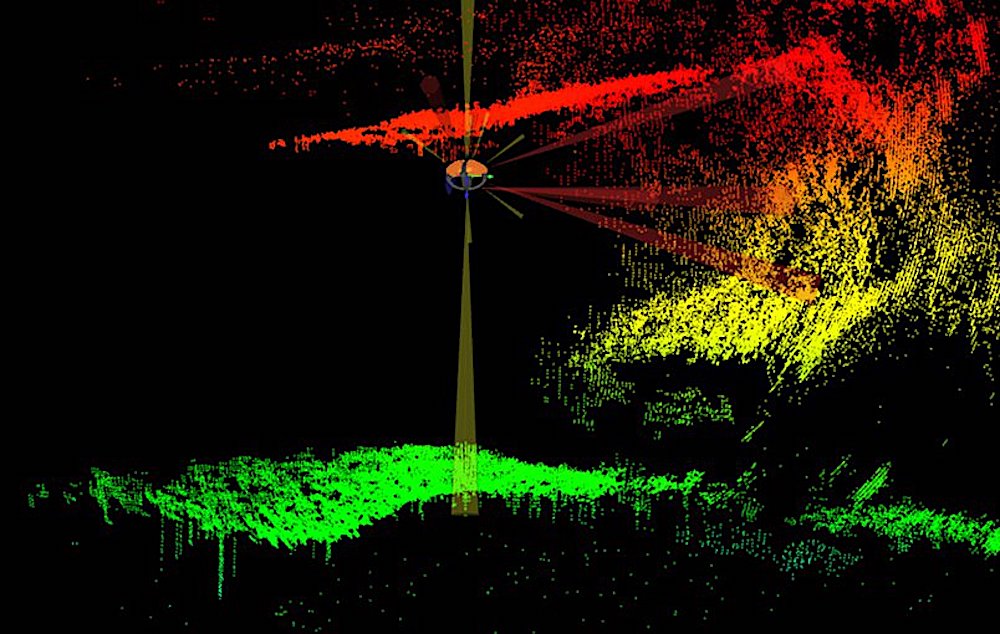
Data from underneath the ice in Antarctica from the Environmentally Non-Disturbing Under-ice Robotic ANtarctic Explorer (ENDURANCE). IMAGE CREDIT: JASON TOWNSEND/STONE AEROSPACE. Sampling Below the Ice
It’s not just the challenges of accessing and maneuvering in environments on other worlds that engineers help us overcome. Engineering also plays a major role in designing and building all of the scientific instruments that astrobiologists use.
With support from NASA and many other agencies and institutions, engineers are constantly designing new instruments used to explore oceans. The instruments are taken out to sea here on Earth, and help us study our own planet. This also gives engineers the chance to perfect the technology for future missions to locations like Europa.
The NASAPSTAR program funded SUBSEA (Systematic Underwater Biogeochemical Science and Exploration Analog) aboard the Exploration Vehicle Nautilus, which discovered a hydrothermal field at the Gorda Ridge in the Pacific Ocean.
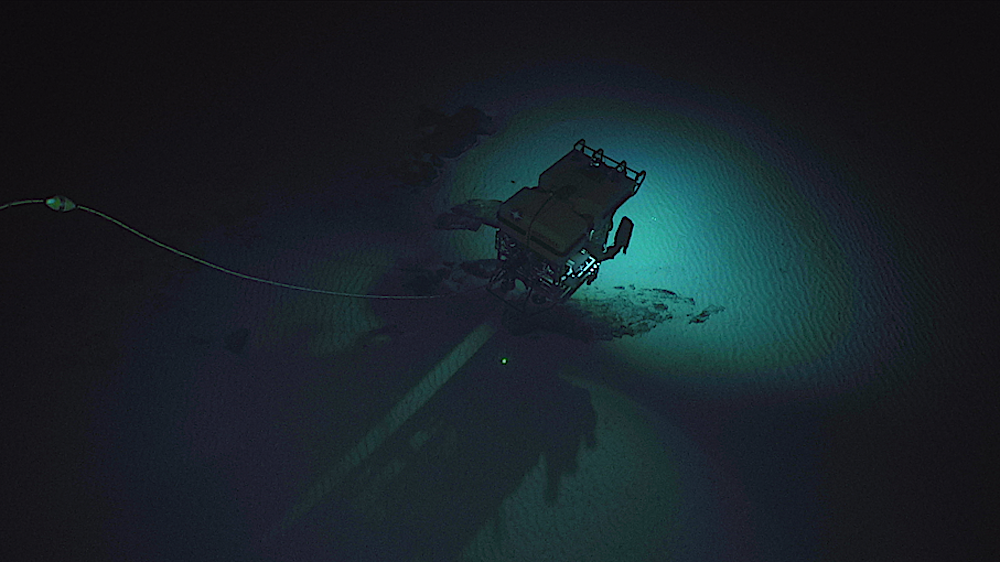
The remotely operated vehicle (ROV) Hercules carrying the InVADER Mission’s Laser Divebot. IMAGE CREDIT: OCEAN EXPLORATION TRUST, NOAA.
In 2023, InVADER (In-situ Vent Analysis Divebot for Exobiology Research) was launched into the deep waters surrounding Kingman Reef and Palmyra Atoll during an Ocean Exploration Trust’s Exploration Vessel Nautilus expedition. Funded by NOAA Ocean Exploration and Research, this expedition marked the first time a high-tech laser laboratory has been integrated into remotely operated vehicle (ROV) operations for in situ sensing and analysis, removing the need to collect physical samples as the first measure-while-in-motion autonomous solution. NASAPSTAR funded InVADER’s development.
A thin beam of light moves up from the bottom of the frame to the center where it strikes a rock partially buried in the sand of the seafloor.

A beam of light from the InVADER Mission’s Laser Divebot mounted on the remotely operated vehicle (ROV) Hercules. IMAGE CREDIT: OCEAN EXPLORATION TRUST, NOAA.
These are just a few examples of how engineers are developing techniques and technology to help overcome the tremendous challenges astrobiologists face when studying an icy ocean world like Europa. And it’s not just in the exploration of ocean worlds that NASA needs engineering skills. Engineers and technologists play an essential part in every aspect of NASA science and exploration, from the laboratory to the Moon, and from Europa to distant stars.
— Aaron Gronstal
Astrobiology



